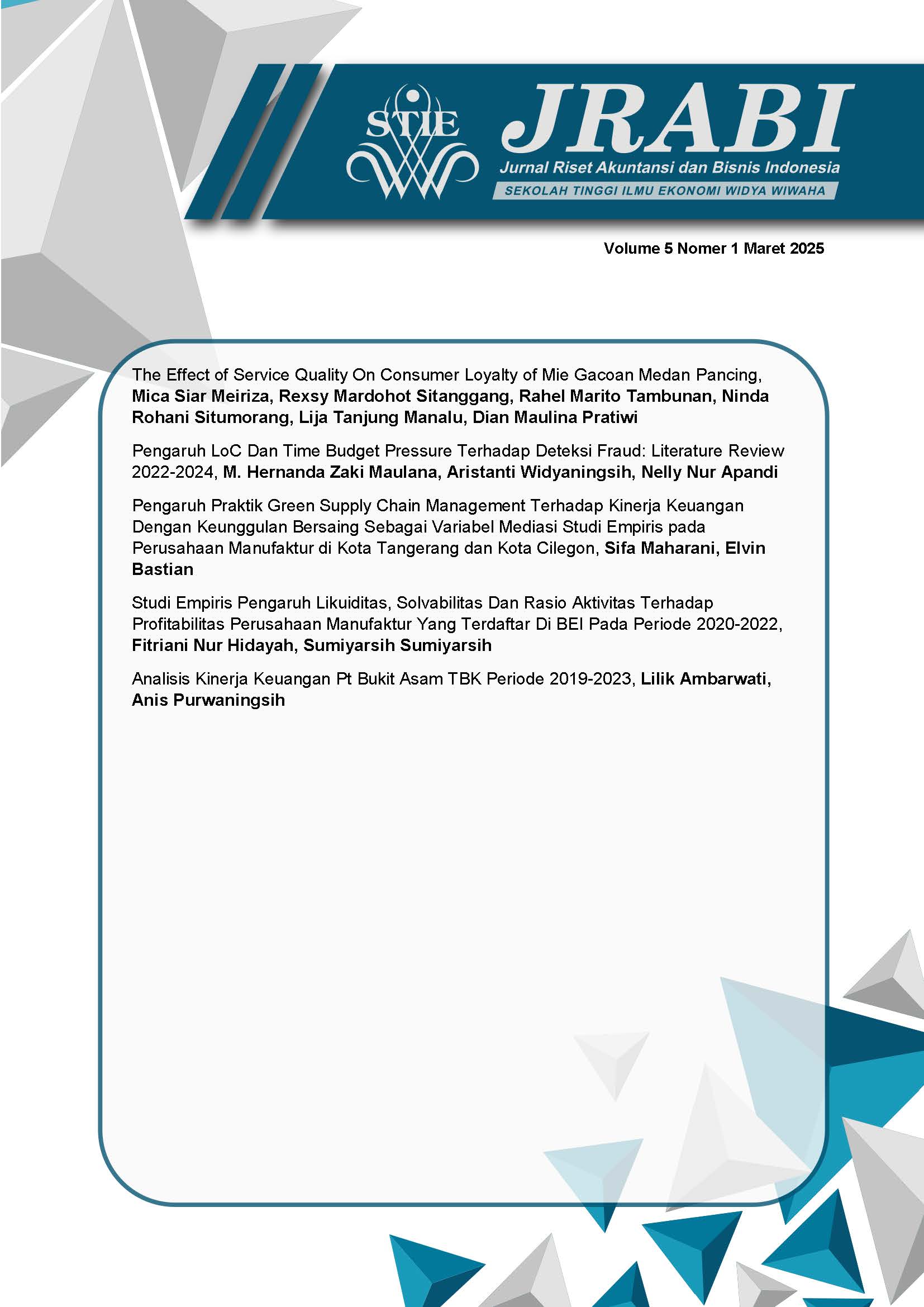ANALISIS KINERJA KEUANGAN PT BUKIT ASAM TBK PERIODE 2019-2023
DOI:
https://doi.org/10.32477/jrabi.v5i1.1162Keywords:
Finansial Performance, Likuiditas, Levarage, Rentabilitas.Abstract
This study's goal is to analyse PT Bukit Asam Tbk's financial operations from 2019 to 2023 by calculating its profitability, solvency, and liquidity ratios. The data shown is based on second-order statistics from the year that was published by the Indonesian Stock Exchange and PT Bukit Asam Tbk. The analysis method used is deskriptif analysis that focusses on analysing financial indicators. The results of the likuiditas rasio for 2019–2023 are good, meaning that the company has the capacity to pay for its obligations or make payments. Conversely, average or solvability indicates that financial performance in a given year isn't very good, and businesses aren't able to use their assets in the best way possible, indicating that many assets are purchased through trading. Conversely, the debt-to-equity ratio indicates that business operations are quite efficient, with many businesses using large amounts of capital as business tools. Rentability, also known as profitability, indicates that the current business's financial performance is not very good, and that it is not very efficient in generating profits from all of its operational activities.
References
A.A. Anwar Prabu Mangkunegara. 2016. Manajemen Sumber Daya Manusia Perusahaan. Bandung: PT. Remaja Rosdakarya.
Aruan, Daniel Arfan. (2013). “Pengaruh Pelatihan Kerja dan Motivasi Terhadap Kinerja Karyawan PT. Sucofindo (Persero) Surabaya”. Jurnal ilmu manajemen Universitas Negeri Surabaya. 1 (2): 565-574 Andayani, Nur
Dessler, Gary. 2015. Manajemen Sumber Daya Manusia. Jakarta: Salemba Empat.
Edy, Sutrisno, (2016), Manajemen Sumber Daya Manusia, Kencana Prenada Media Group, Jakarta.
Elnaga, A., & Imran, A. (2013). The Effect of Training on Employee Performance. European Journal of Business and Management. ISSN 2222-1905 (Paper) ISSN 2222-2839 (Online) Vol. 5, No. 4, 2013.
Hasibuan, Malayu Sp. 2012. Manajemen SDM. Edisi Revisi, Cetakan Ke Tigabelas. Jakarta: Bumi Aksara.
Jagero, D. N., H. V. Komba, et al. (2012). "Relationship between on the Job Training and Employee’s Performance in Courier Companies in Dar es Salaam, Tanzania." International Journal of Humanities and Social Science 2(22): 114-120.
Robbins, P. Stephen & Coutler, Mary. 2016, Human Resources Management, Edisi 16, Jilid 1, Salemba Empat, Jakarta.
Sandy Martha, Muhammad. 2015. “Karakteristik Pekerjaan dan Kinerja Dosen Luar Biasa UIN Sunan Gunung Djati Bandung: Komitmen Organisasi Sebagai Variabel Moderating”. Tesis di Universitas Widayatama Bandung.
Santoso, Singgih. 2012. Panduan Lengkap SPSS Versi 20. Jakarta: PT Elex Media Komputindo
Sedarmayanti, M., & Pd, M. (2001). Sumber Daya Manusia dan Produktivitas Kerja. Bandung: Mandar Maju.
Sedarmayanti. (2014). Sumber Daya Manusia dan Produktivitas Kerja. Jakarta: Mandar Maju
Sedarmayanti. 2016. Manajemen Sumber Daya Manusia Reformasi Birokrasi Dan Manajemen Pegawai Negeri Sipil. Bandung: PT. Refika Aditama.
Sugiyono (2015). Metode Penelitian Kombinasi (Mix Methods). Bandung: Alfabeta.
Sugiyono, D. (2014). Metode Penelitian Kuantitatif Kualitatif dan R&D. Bandung: CV Alfabeta.
Syahyuti. 2010. Defenisi, Variabel, Indikator dan Pengukuran dalam Ilmu Sosial, Bina Rena Pariwara, Jakarta
Tanujaya, Lia Riantika. 2015. Pengaruh Pelatihan Kerja Dan Motivasi Kerja Pada Kinerja Karyawan Departement Produksi PT. Coronet Crown. AGORA, 3(1), h:1-7.
Triasmoko, Denny., dkk., 2014, Pengaruh Pelatihan Kerja Terhadap Kinerja Karyawan, Jurnal Admnistrasi Bisnis Vol.12 No. 1, Unversitas Brawijaya, Malang.
Wahjono, Sentot Imam. (2010). Perilaku Organisasi. Yogyakarta: Graha Ilmu.







